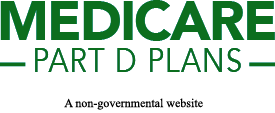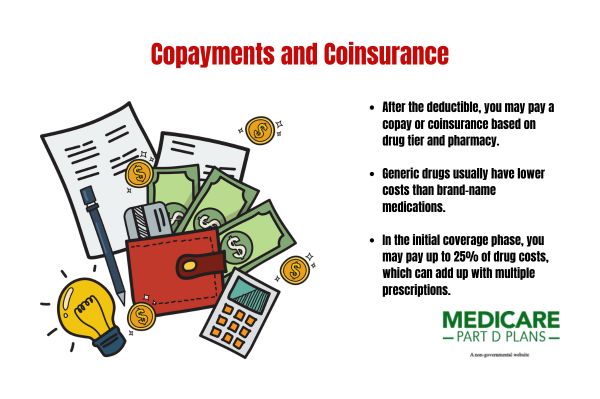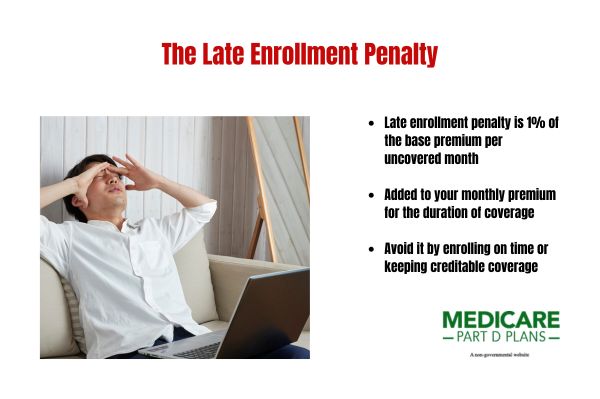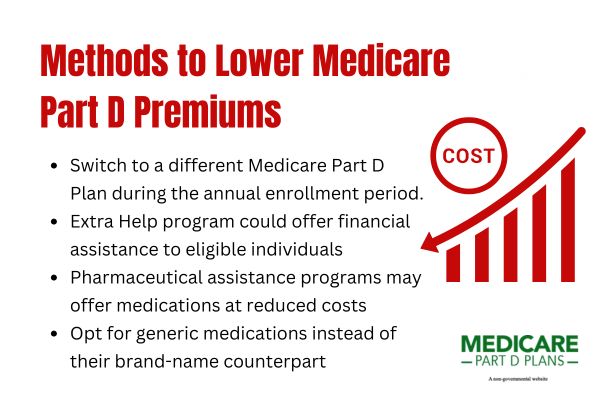Find a Medicare Part D prescription drug plan

Medicare Part D
Prescription Drug Coverage 2026
Part D Medicare Costs
Understanding Medicare Part D costs is essential for managing your healthcare budget. This article explains monthly premiums, annual deductibles, copayments, and how your income may affect these Part D Medicare costs. You’ll also learn strategies to help reduce these expenses.
Key Takeaways
In 2026 , the average monthly premium for Medicare Part D is approximately $46.50, which will likely be influenced by plan specifics and income, and higher earners might face potential surcharges.
- The maximum annual deductible for Part D plans is $590, after which beneficiaries might share costs with their plan until total drug costs reach $2,000.
- High-income earners may incur additional costs under the income-related monthly adjustment amount (IRMAA), and delaying enrollment could lead to a permanent late enrollment penalty.
Monthly Premiums for Part D Medicare Plans
Medicare Part D premiums will likely be a significant cost. Based on data from recent years, the average monthly premium for Part D plans was approximately $46.50, with the national base beneficiary premium was around $36.78. Premiums are the monthly payments to maintain drug coverage, which may vary based on the plan specifics and your income.
Several factors may influence these premiums, such as the number and types of drugs covered by your plan and any additional out-of-pocket expenses you might incur for medications and other costs. Higher-income beneficiaries may also face additional surcharges, known as the income-related monthly adjustment amount (IRMAA), which could increase the overall cost of maintaining Medicare Part D.
The method of payment will likely be flexible, which may allow deductions directly from your bank account or Social Security payments.
Failing to enroll in Part D when first eligible might result in a late enrollment penalty, which could permanently increase your monthly premium. Planning for these costs during your Medicare initial enrollment period will likely help you avoid these unexpected expenses.
Annual Deductibles in Part D
The annual deductible will likely be another key component of Medicare Part D costs.
- The maximum deductible for most plans is $590.
- Beneficiaries might pay the full price of their medications until this deductible has been met.
- After the deductible is met, drug coverage begins.
Once the deductible has been met, you enter the initial coverage period, where you might share the costs of your medications with your plan. For example, after reaching the deductible, coverage will likely continue until your total drug costs hit $2,000.
Out-of-pocket expenses that count towards this cap might include the deductible, initial coverage costs, and amounts paid by others on your behalf.
Some plans may also offer a $0 deductible for immediate access to coverage, which could be beneficial for those needing regular medications and avoiding high upfront costs. Knowing how deductibles work could help manage out-of-pocket spending effectively while paying attention to overall costs.
Copayments and Coinsurance
Medicare Part D plans will likely include two main types of out-of-pocket costs: copayment and coinsurance. Copayments are fixed amounts paid for prescriptions, which may vary with the medication’s tier. Lower-tier medications might have lower copayments, possibly making them more affordable.
Coinsurance is a percentage of the drug’s cost. During the initial coverage phase, beneficiaries may pay up to 25% of drug costs after meeting the deductible. This phase will likely last until total drug costs reach $2,000, after which catastrophic coverage begins, possibly reducing out-of-pocket expenses.
Coverage Phases of Part D Prescription Drug Plans
Medicare Part D prescription drug plans will likely be structured into different coverage phases:
- The deductible stage
- Initial coverage stage
- Catastrophic coverage
Knowing these phases could help members manage out-of-pocket drug costs effectively throughout the year.
The first phase is the deductible stage, where you might pay the full cost of your medications until you meet the deductible amount. Once the deductible has been met, you enter the initial coverage stage, where cost-sharing begins, typically with an approximate 25% coinsurance until your total drug costs reach $2,000.
After reaching the $2,000 out-of-pocket threshold, you enter the catastrophic coverage phase, where the plan may pay up to 100% of covered medication costs for the rest of the year.
This phase could potentially ensure that beneficiaries are not burdened with excessive drug costs beyond this point, possibly providing significant financial relief.
The Potential Impact of Income on Part D Costs (IRMAA)
High-income earners may face additional costs under Medicare Part D due to the income-related monthly adjustment amount (IRMAA).
- Individuals with an income of about $106,000 or less might not have to pay IRMAA.
- Couples with an income of about $212,000 or less might not have to pay IRMAA.
- Those exceeding these income thresholds may see an increase in their Part D costs.
The IRMAA will likely be calculated based on your income reported in your 2023 tax return and may be paid directly to the Social Security Administration if you are not collecting Social Security benefits or receiving a social security check.
Knowing how your income might affect Medicare costs will likely be essential for budgeting and planning healthcare expenses effectively.
Late Enrollment Penalty for Part D
One of the common pitfalls in Medicare Part D is the late enrollment penalty:
- This penalty acts as a permanent increase to your monthly Part D premium if you delay enrolling when first eligible.
- The penalty is calculated at 1% of the national base beneficiary premium for each month you were eligible but didn’t enroll.
- Based on data from recent years, this amount may be around $36.78 multiplied by the number of months you delayed enrollment.
If there is a continuous period of 63 days or more after your initial enrollment period during which you were eligible but not enrolled, you will incur this penalty. There is no cap on the number of months for the penalty, meaning it will likely continue to increase the longer you delay enrollment.
To avoid this penalty, promptly enroll in a Part D plan upon eligibility and maintain records of your insurance history. This proactive approach could prevent a permanent increase in Medicare costs.
Ways to Lower Your Part D Drug Costs
Several strategies may help to lower Medicare Part D drug costs. Enrolling in the Extra Help program could potentially reduce prescription expenses if you qualify, with some costs as low as $4.90 for generics and $12.15 for brand-name drugs.
Switching to generic medications could be another cost-saving strategy. Generics drugs will likely be cheaper than brand-name drugs while offering the same benefits. Discussing these options with your healthcare provider or local pharmacies could help you make cost-effective choices.
See plans in your area instantly!
Advertisement
How to Choose the Right Part D Plan
Choosing the right Medicare Part D plan might be daunting but is crucial for managing drug costs effectively. Options might include separate Medicare drug plans and a Medicare Advantage plan with drug coverage. However, joining a separate drug plan might affect coverage with certain Medicare health plans.
When choosing a Medicare plan, consider the following:
- Ensure the plan covers your regular medications.
- Compare different plans to identify the best coverage for your needs and financial situation.
- Use tools like the Plan Finder on this website to facilitate these comparisons and find a suitable plan.
Starting in 2025, those receiving Medicaid or Extra Help might have additional options for changing drug coverage monthly. Utilizing these resources could help make informed decisions and avoid unexpected costs.
Possible Updates for 2026 Part D Changes
As we look ahead to
- The annual deductible for Part D in CY
2026 is set at $615.
- During the initial coverage phase, enrollees will likely continue to pay 25% coinsurance.
- Plan sponsors might cover up to 65% of the applicable drug costs.
Another one of the potential changes might include a new policy that might the process of determining out-of-pocket maximums for beneficiaries. The Centers for Medicare & Medicaid Services has released the Final Calendar Year (CY)
Staying informed about these updates could help plan and budget for future Medicare Part D costs more effectively.
Find a Plan and Enroll Online Yourself!
Advertisement
Summary
Understanding the various nuances of Medicare Part D costs is essential for managing your healthcare expenses. From monthly premiums and annual deductibles to copayments, coinsurance, and the potential impact of income on your costs, each component will likely play a crucial role in determining your overall out-of-pocket spending.
By staying informed about upcoming changes, avoiding penalties, and employing cost-saving strategies, you could make Medicare Part D work for you. Remember, choosing the right plan tailored to your specific needs and financial situation is key to maximizing your benefits and minimizing your expenses.
Frequently Asked Questions
What is the annual deductible for Part D in CY 2026 ?
The annual deductible for Part D in CY
How is the IRMAA calculated for Medicare Part D?
The IRMAA for Medicare Part D is calculated using your income reported on your 2023 tax return, specifically targeting high-income earners. It’s essential to be aware of this as it might affect your monthly premiums.
What happens if I delay enrolling in Medicare Part D?
Delaying enrollment in Medicare Part D could result in a late enrollment penalty, amounting to 1% of the national base beneficiary premium for each month you postpone signing up. Members should enroll during the Open Enrollment Period avoid these additional costs.
Are there programs to help reduce my Medicare Part D costs?
Yes, programs such as Extra Help will likely be available to reduce your Medicare Part D costs if you meet the eligibility criteria.
How can I choose the right Medicare Part D plan?
Choosing the right Medicare Part D plan will likely involve using tools like the Plan Finder on this website to compare plans and verify that they cover your regular medications. This approach could potentially ensure you select the most suitable option for your healthcare needs.
Begin Choosing your plan
Advertisement
ZRN Health & Financial Services, LLC, a Texas limited liability company.




